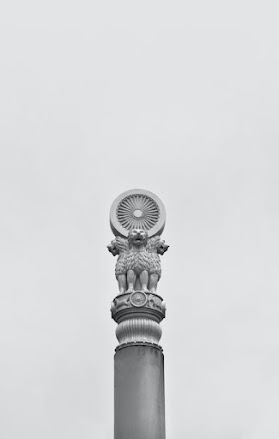Trick to remember places where ashoka's 7 inscription found/ उन स्थानों को याद करने की ट्रिक जहां अशोक के 7 शिलालेख मिले हैं
====================================================
TRICK
MaaR DALA
|
Place |
Trick |
|
Meerut (uttar pardesh) |
M |
|
Rampur (uttarakhand)
|
R |
|
Dehli |
D |
|
Allahabad (uttar pardesh |
A |
|
Lauriya(pakistan) |
La |
|
Lauriya pakistan |
La |
Some Extra Information
There are seven pillar edicts.
Two types of stones are used: speckled white sandstone (from Mathura) and beige sandstone and quartzite (from Amaravati). Generally, they are made of sandstone mined in Chunar. They are almost similar in shape and size. All the pillars are monoliths (carved in stone) and the surface is well polished.
They have been found in several places such as Kandahar (Afghanistan), Khyber Pakhtunkhwa (Pakistan), Delhi, Vaishali and Champaran (Bihar), Sarnath and Allahabad (Uttar Pradesh), Amaravati (Andhra Pradesh) and Sanchi (Madhya Pradesh). Fragments of the same edict are found in different places.
Many pillars are up to 50 feet tall and weigh up to 50 tons. They lack bases and the cylindrical axis tapers slightly upwards to a height of 12-14 m. A cylindrical latch joins the top of the shaft to the capital, and has a bell-shaped capital (a stone carved in the shape of an inverted lotus). There is a platform (abacus) on top of the capital of the bell that supports the crowned animal.
The pillars represent animals such as elephants, lions, wheels and lotus flowers, which are significant symbols in Buddhism. I maestosi editti dei pilasteri si trovano a Topra, Rampurva, Nigali Sagar, Lauriya-Araraj, Lauriya Nandangarh, Sarnath and Meerut. Feroz Shah Tughlaq has shifted the pilasters, one from Topra and the other from Meerut, to Delhi.
ट्रिक
MaaR DALA
Place | Trick |
मेरठ | M |
रामपुर उत्तराखंड
| R |
देहली | D |
अल्लाहाबाद | A |
लौरिया | La |
लौरिया | La |
कुछ अतिरिक्त जानकारी
सात स्तंभ शिलालेख हैं।
दो प्रकार के पत्थरों का उपयोग किया जाता है: धब्बेदार सफेद बलुआ पत्थर (मथुरा से) और बेज बलुआ पत्थर और क्वार्टजाइट (अमरावती से)। आमतौर पर, वे चुनार में खनन किए गए बलुआ पत्थर से बने होते हैं। वे आकार और आकार में लगभग समान हैं। सभी स्तंभ अखंड (पत्थर में नक्काशीदार) हैं और सतह अच्छी तरह से पॉलिश की गई है।
वे कई स्थानों जैसे कंधार (अफगानिस्तान), खैबर पख्तूनख्वा (पाकिस्तान), दिल्ली, वैशाली और चंपारण (बिहार), सारनाथ और इलाहाबाद (उत्तर प्रदेश), अमरावती (आंध्र प्रदेश) और सांची (मध्य प्रदेश) में पाए गए हैं। एक ही शिलालेख के अंश भिन्न-भिन्न स्थानों पर मिलते हैं।
कई खंभे 50 फीट तक ऊंचे और 50 टन तक वजनी हैं। उनके पास आधारों की कमी है और बेलनाकार अक्ष 12-14 मीटर की ऊंचाई तक थोड़ा ऊपर की ओर झुकता है। एक बेलनाकार कुंडी शाफ्ट के शीर्ष को राजधानी से जोड़ती है, और इसमें एक घंटी के आकार की राजधानी होती है (एक उल्टे कमल के आकार में नक्काशीदार पत्थर)। घंटी की राजधानी के शीर्ष पर एक मंच (अबेकस) है जो ताज पहने हुए जानवर का समर्थन करता है।
स्तंभ हाथियों, शेरों, पहियों और कमल के फूलों जैसे जानवरों का प्रतिनिधित्व करते हैं, जो बौद्ध धर्म में महत्वपूर्ण प्रतीक हैं। आई मैस्टोसी एडिट देई पिलास्टरी सी ट्रोवानो ए टोपरा, रामपुरवा, निगाली सागर, लौरिया-अराज, लौरिया नंदनगढ़, सारनाथ और मेरठ। फ़िरोज़ शाह तुगलक ने तीर्थयात्रियों को स्थानांतरित कर दिया है, एक टोपरा से और दूसरा मेरठ से, दिल्ली में।
आपके सहयोग के लिए धन्यवाद
कृपया फिर से पधारें
अधिक ट्रिक के लिए कृपया इस वेबसाइट को शेयर करें
Thank You for your support
please visit again
please share this website for more trick

